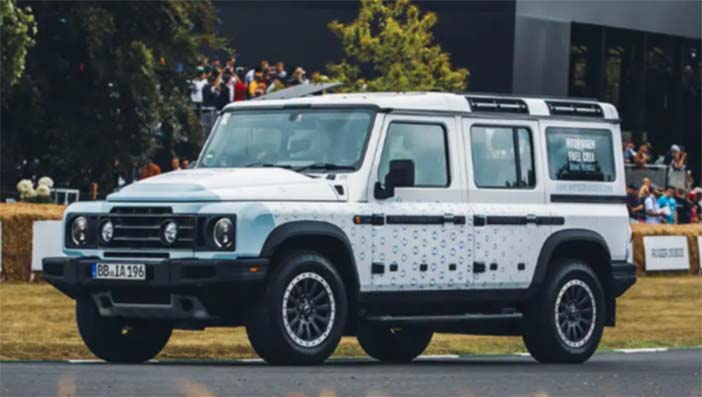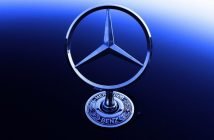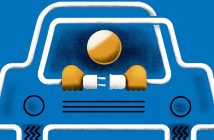+++ The Formentor is CUPRA ’s best-selling car and the Spanish brand is clearly keen to keep it fresh with a new facelift on the way. I’ve spotted the revised compact SUV out testing on the road again and learned a little bit more about what the facelifted Formentor will have in store. Arriving in late 2020, the Formentor is a sporty coupe-SUV that sits on the same MQB Evo platform as the Seat Leon and Volkswagen Golf. A whopping 63.8 percent of Cupra sales were down to the Formentor in 2022 with Cupra as a brand steadily closing the sales gap to Seat. To help maintain this newfound momentum, the Formentor will gain plenty of exterior tweaks to keep it looking fresh. I expect to find some changes to the cabin too. At the front there’s a completely new grille with a horizontal shape and new led headlight cluster that mimics the new Tavascan with 3 individual lights. The lower front bumper will also be revised with new air intakes. The side of the car is undisguised, showing no changes. We could potentially see the Formentor given some new alloy wheel choices, however, along with some new trim colors. The rear on previous test cars has been on show as well but this prototype has been given camouflage to hide a new rear diffuser and side air vents. The overall layout of the interior shouldn’t change too much. A 12 inch central touchscreen should still be available on every Formentor model as is wireless Android Auto and Apple CarPlay connectivity. I hope to see the touch-sensitive climate control slider become backlit to make it easier to use at night. The infotainment itself will gain similar updates seen on the Volkswagen Golf last year. +++
+++ The EURO NCAP crash testing body has added new requirements to its testing regime for 2023 that include a requirement that electric windows and doors will work underwater. Perhaps with a view to rising incidences of global warming-induced flash flooding, but more likely as a response to the increasing number of vehicles entering production with electrically-operated door catches, the test body will now insist that any car so-equipped must ensure windows and doors remain operable when submerged – at least for a period of time that’s deemed long enough for any occupants to make their escape. Children left behind in locked cars anywhere are another area where Euro NCAP is intervening, with a new requirement that 5 star cars must have Child Detection Systems that will monitor the car’s interior for the presence of an occupant, and will be able to notify the driver, or the emergency services, if parents accidentally forget to let their kids out of the car. The Euro NCAP testing program has evolved a long way from its launch in 1997, when the institute launched its first star rating system that evaluated adult occupant protection in frontal and side impacts, and the safety of pedestrians hit in frontal impacts. Back then the car industry claimed no car could meet the tough ‘4 star’ standard, but the Volvo S40 did just that later in the same year. “We continue to be a catalyst for continuous safety improvements in passenger vehicles through its rating program. As mobility evolves through developments in technology and society, so do Euro NCAP’s rating requirements”, the institute says. “The influence of the Euro NCAP rating program and ‘Vision Zero’ (striving to eliminate fatalities and serious injury in road crashes) help make today’s cars safer than ever”. As well as the 2 test upgrades mentioned above, the latest 2023 regime includes an assessment of how well Autonomous Emergency Braking systems (AEB) detect and respond to motorcycles in their path, or when turning, which is a level of sophistication many manufacturers have yet to deploy. Also on the 2023 test agenda is a vehicle’s ability to detect and prevent high-speed head-on crashes, or crashes involving paths crossing at T-junctions, both requiring sensors with a wide field of view and a longer range than those that are typically fitted today. Collision-avoidance testing is broadened to include AEB when reversing to detect a small child behind the car, and Euro NCAP says it will also be protecting cyclists by assessing vehicle systems that warn the driver or delay sudden door-opening in the event of a cyclist approaching. Euro NCAP says it has already awarded five-star ratings to a pair of vehicles under the new test regime: the Chinese-manufactured Nio ET5 and EL7. “Nio is one of the first manufacturers on the market to mount an ultra-long-range Lidar sensor on the roof of both cars. The distinctive sensor is roof-mounted above the windscreen in what Nio calls the watch-tower position, which enables the sensor to operate over a long-range, aiding performance at high speed by offering a better view of the road ahead”. Euro NCAP secretary general Michiel van Ratinge acknowledges that as the ratings get tougher, the challenges are more daunting for manufacturers. “However, Nio has stepped up to the challenge and achieved a 5-star results twice, underlining their big ambitions for the brand”, he said. “Safety technologies are becoming complex, yet I want to reassure consumers that Euro NCAP will continue to anticipate and adapt to changes in our rating scheme, challenging vehicle manufacturers to ensure drivers (and the road users they interact with) are offered the safest possible vehicles”. +++
+++ FIAT will unveil the first of a new family of affordable cars on July 11 2024, its 125th anniversary, and it is set to take cues from the Panda, which began production in 1980 and which has become an icon of utilitarian motoring thanks to its boxy style and simple engineering. Described by company CEO Olivier Francois as “like Dacia, but full of intangibles that will delight you” the new family of cars will exist under the tag line of being “inclusive, ingenious and Italian”. That raises the prospect of a family of vehicles, potentially in the vein of the Punto and Uno, although the company boss coyly refused to give any specific details of what types of cars would be launched, beyond confirming they would be between 3.6 and 4.5 long, excluding the quadricycle-based Topolino. “We can absolutely crack the code of small, affordable, fun cars”, said Francois. “We are focused on making something simple, cool, joyful, you know, a little bit special. We have this DNA, and maybe we can take some design cues from the Panda and the 1980s and bring that back to life”. Francois reasoned that Fiat’s history puts it in a unique position, even over budget market leader Dacia, to launch cars at the affordable end of the market: “In our DNA is an acceptance that less is more; a simple car made by the Italians is not a punishment but a joy; a simple car made by anyone else is a punishment. Even in Romania where Dacia’s are made, where it is well done, it is not gratifying at all”, he said. Raising prospects that the line-up of affordable Fiats would include a Panda-inspired vehicle, Francois confirmed that the company was open to having more than one B-segment car in its line-up, alongside the 600e that will go on sale later this year. Describing the 600e as a “something between a hatchback and a crossover”, he namechecked the Panda when talking about having another car in that space in the market. “Everyone was convinced that the segment would disappear, but from what I see it is not so much disappearing: we have more requests for Panda than ever”, he said. “I think that you will have probably that car; we have the capacity to make another B-segment car in a more democratic, essential way. “What we create has to follow European tastes 100%, but we need it to be a player in Middle East and Africa and markets like that. This is a reason why I said that there may be space for something as well as the 600, which is very European in its targets”. Asked further about it would be inspired by the Fiat Centoventi concept, which was said to preview a new Panda when it was shown at the Geneva motor show in 2019, Francois elaborated: “Fiat has 2 sides. One side is a little more vintage and emotional, and today with the Topolino, 500 and 600 we have shown that side. The other side we are going to see next year. It may be that we do that through exploration of some of the ideas of Centoventi. It may not look exactly like that but there may be aspects that you are going to recognise. The Centoventi was our laboratory to show some of the other side of Fiat that I have been alluding to”. He did, however, rule out some of the concept’s more extravagant flourishes, such as a swappable battery, making production at present. “What we present next year will have may ideas from that concept, but battery swapping will not be one. Maybe on the next generation, but in our talks with suppliers it is an idea that went nowhere”, he said. However, it is expected that both hybrid and electric versions of the cars will be offered, the former powertrains key to keeping costs down. Francois also underlined that any affordable cars from Fiat would have to be a global sellers in order to achieve the desired profit margins for the brand, suggesting that it could potentially be based on Stellantis’s ‘Smart Platform’: a cost-focused evolution of the existing CMP and e-CMP architectures that has only been used so far in India and South America but which is set to underpin the upcoming Citroën ë-C3. The ë-C3 is targeting an entry price of 25.000 in the Netherlands, substantially undercutting rivals. Asked about pricing, Francois said: “It will be a challenge, but we are working on that. Today, the cost of electrification of the 500e is our main challenge; we need to remain flexible and open to what is essential”. Consequently, he also conceded that buyers may have to forgo some safety kit in order for the cars to be priced competitively. Dacia has taken the same approach, meeting all safety regulations but forgoing some of the technology that is required to get higher star ratings in increasingly strident and crash-avoidance technology-focused NCAP tests. Despite this, Dacia has enjoyed huge sales success across Europe. “The challenge is not technical, we can add all the equipment to get the stars, but the question is whether customers want to pay for it”, said Francois. “In most cases we will probably put the equipment on our cars, but when you are dreaming of making a car like the Panda in the 1980s you have to decide what you want; is it really a sacrifice if it doesn’t have an autonomous driving mode? Are these features that a customer can objectively live without? I think so. Am I ready to sacrifice these features. Yes. We will meet all regulations, but if it is horribly expensive we will not always do more than is necessary”. We’ve previously had some insight into how the new Panda could shape-up on the inside, courtesy of an interior design concept revealed by the Italian brand. As part of the Italian company’s centenary celebration for its famous Lingotto factory, a video hinted at some details of cars that Fiat said will enter the market from 2024. The rounded dash and center console of the cabin design mimic the roof of the Lingotto, which doubled up as a testing facility for Fiat models. Elsewhere, there are speakers integrated into the headrests and even the steering wheel has taken on the oval look of the test track. An image of the car’s exterior reveals a bluff front end with a wraparound lightbar made up of dozens of led units. I’m not certain which elements of these concept images will make it to production, although it’s clear that Fiat wants to retain much of the cheerful styling its family cars have become known for. In terms of exterior design, we should see a limited range of colors but personalizing through optional wraps, and chunky plastic rubbing strips to protect against urban scrapes, are likely to be retained. +++
+++ INEOS AUTOMOTIVE Automotive has revealed a hydrogen-fuel-cell variant of its Grenadier 4×4 at the Goodwood Festival of Speed, intended to prove its commitment to lower-carbon fuels. It trades the conventional Ineos Grenadier’s choice of BMW-supplied combustion engines for BMW’s latest hydrogen-fuel-cell stack. Ineos told that this holds 5 kg of the fuel, giving a range of around 200 km between fill-ups. The firm said it would target 550 km in an eventual production model. The demonstrator uses 3 electric motors (one up front and one on each rear wheel). Ineos said it would aim to include an additional motor at the front on a production model. However, Ineos would not be drawn on the motors’ power output, saying instead that “the key is torque” for an off-roader. According to Ineos, the set-up’s torque-vectoring capabilities provide improved manoevrability on the rough stuff, with a tighter turning circle. Such advantages have already been capitalised on in other electrically powered 4x4s. The Rivian R1 and the upcoming Mercedes-Benz EQG can both perform ‘tank turns’, able to rotate at a complete standstill. The GMC Hummer, meanwhile, can ‘crab walk’: driving side to side using vectoring alone, without steering input. Switching to a fuel-cell powertrain has not compromised the Grenadier’s capabilities, said Ineos, with the new variant also having completed the same Schöckl mountain pass in Austria that was integral to the development of the ICE model. Ineos’s decision to choose hydrogen over battery-electric is rooted in its chemicals business, because the firm produces 400.000 ton of hydrogen annually. Should the Grenadier FCEV receive the production go-ahead (a likelihood, given the firm already notes its ‘power bulge’ bonnet would not be present on a production model, and has divulged target specifications) it would effectively create a virtuous circle for Ineos, boosting demand for its hydrogen. As previously reported by Autocar, work on the project began with British engineering firm AVL in late 2021 and road testing took place throughout 2022. It was originally tipped to use a Hyundai powertrain after Ineos signed a memorandum of understanding (MoU) with the South Korean company to “explore the use” of a FCEV powertrain in the Grenadier. Hyundai has been prolific with FCEVs, selling the Nexo in selected markets and last year showing the N Vision 74 concept, which uses a 62.4 kWh battery, a 95 kW fuel cell and 2 motors making a combined 670 hp. “Our demonstrator proves that the technology is capable”, said Ineos Automotive CEO Lynn Calder, “but what we need now is support from policy makers to help provide the infrastructure for the next generation of hydrogen vehicles”. Calder said at the Financial Times Future of the Car Conference in May that “the broader the technology options, the better the outcome will be” for reducing the transport sector’s carbon emissions. +++

+++ The European passenger car market expanded by some 18 percent year-over-year, reaching close to 1.1 million new registrations in May. The PLUG-IN ELECTRIC CAR segment expands even faster, thanks to the booming all-electric segment. In May, 253.779 new plug-in electric cars were registered in Europe, which is roughly 38 percent more than a year ago. That’s also 23 percent of the total volume. It’s worth paying attention to the battery-electric car segment because in this category the year-over-year growth amounted to 67 percent (some 165.500 and 15 percent of the market). Meanwhile, plug-in hybrid car registrations barely increased (by 1 percent year-over-year) to 88.300 units. So far this year, 1.123.149 passenger plug-in electric cars (up 24% year-over-year) were registered in Europe, which is about 21 percent of the total market. BEVs sold about 0.72 million and had a 14% share. PHEVs did 0.39 million and had a 7% share. For reference, in 2022, more than 2.6 million new passenger plug-in electric cars were registered in Europe (about 23 percent of the total volume). The Tesla Model Y remains the best-selling plug-in model in Europe in May (21.967 registrations) and it has held this top spot for the 7th consecutive month. No other BEV is even close, although the improving sales of the Volkswagen ID.4 enabled it to regain second position (8.600 registrations in May; we must also remember that the trio of MEB-based electric crossovers from the Volkswagen Group (ID.4, Audi Q4 e-Tron and Skoda Enyaq iV noted) 20.859 units total). Next came the Volvo XC40 (BEV + PHEV) at 8.233, the MG 4 at 6.535, the Fiat 500e at 6.347, the Skoda Enyaq iV at 6.302, the Tesla Model 3 at 6.265, the Audi Q4 e-Tron at 5.957, the Volkswagen ID.3 at 5.609 and the BMW i4 at 4.572. Over the first 5 months, the Tesla Model Y’s advantage over the rest of the pack increased to some 70.000 units with 105.307 sales. Meanwhile, the Volkswagen ID.4 (31.481 sales) is now the third most popular model. In between comes the Volvo XC40 (BEV + PHEV) with 35.226 sales, while the Tesla Model 3 (28.968) and Volkswagen ID.3 (28.959) switched positions. The rest of the top-10 consists of the Audi Q4 e-Tron (26.371 sales), the Fiat 500e (24.615), the MG 4 (23.539), the Skoda Enyaq iV (23.142) and the Dacia Spring (22.142). Tesla remains the most popular plug-in car brand in Europe by registration volume, but as an automotive group, it’s now slightly behind Stellantis (when counting BEVs and PHEVs together). The top plug-in brands (share year-to-date) are: Tesla – 12.4%, Volkswagen – 8.3%, BMW – 7.9%, Mercedes-Benz – 7.7%, Volvo – 6.5%, Audi – 5.3% and Peugeot – 4.7%. The top plug-in automotive groups (share year-to-date) are: Volkswagen Group – 19.8% share, Stellantis – 13.9%, Tesla – 12.4%, BMW Group – 9.5% share, Geely – 9.3% and Mercedes-Benz Group – 8.6%. +++
+++ After years of negotiations that led to nowhere, TESLA and India may finally be able to meet in the middle. According to a report from the Times of India, Tesla has opened discussions with the Indian government about setting up a vehicle assembly plant in the country with an annual capacity of up to 500.000 cars. Tesla is reportedly planning to produce an electric vehicle model that would start around €23.000 in the Netherlands. No details are available about the car, which would become Tesla’s most affordable model if it comes to fruition. Interestingly, that’s roughly the same price target Tesla has advanced for its future small EV that it plans to build in China and Mexico. It would certainly make sense to produce the car in India as well given the country’s low production costs. In addition, the American maker is looking at using India as an export base for countries in the Indo-Pacific region, government sources told the paper. “Tesla has come to us with an ambitious plan, and we are confident that the movement will be positive this time around, especially as it involves both local manufacturing and exports”, a source told Times of India. Apparently, the commerce and industry ministry is leading the talks and the government is hoping to put forth a “good deal” while making sure that a level-playing field is maintained for other automakers. This latest development in the Tesla-India relations comes not long after CEO Elon Musk met with Prime Minister Narendra Modi on 21 June during the Indian leader’s visit to US. Musk said on the occasion that he was a “fan of Mr. Modi”, adding that the PM had been pushing him to invest in India. “Mr. Modi really cares about India because he’s pushing us to make significant investments in India, which is something we intend to do. We are just trying to figure out the right timing”, Musk told reporters last month. “I am confident that Tesla will be in India and will do so as soon as humanly possible”. The Indian government has always been adamant that it wouldn’t open its car market to Tesla unless the automaker pledged to build an assembly plant in the country. India has been an important target market for Tesla for years but the EV maker abandoned plans to move in last year when the government refused to grant special incentives that would have allowed it to import EVs to India at lower duty. After a long stalemate, Tesla reopened discussions with the Indian government in May when a team from the company visited the south Asian country a month ahead of Modi’s visit to the US. +++
+++ VOLKSWAGEN brand chief Thomas Schäfer said during a recent internal meeting with the company’s managers that “the roof is on fire”, suggesting that “all is at stake” for the German carmaker as it seeks to become a leading manufacturer of EVs while also supplying global markets with internal combustion engine vehicles. The meeting comes after mixed results for the firm’s all-electric business. In the United States, sales of the ID.4 quadrupled in the second quarter compared to last year, with 6.690 vehicles sold, whilst a section of the European Emden plant in Germany, specifically the site where the ID.4 is assembled, has been closed for 6 weeks at the end of last month due to weak demand. With this in mind, Schäfer indicated to the over 2.000 managers that the next weeks and months will be “very tough” and leaned on them to make “small wins”. He also plans to introduce a new series of so-called “performance programmes” that have the goal of saving the company a massive €10 billion in spending over the next 3 years. “We are letting the costs run too high in many areas”, Volkswagen’s CEO said, calling for an immediate freeze on spending as the brand continues to invest heavily in new EV technology and production infrastructure. Also, sales in China have been underwhelming and the German brand has been forced to lower the price of its most profitable models to remain competitive, but that also means lower profit margins. For example, the all-electric ID.3 hatchback’s price has been slashed to just €15.700 in China, making it half as expensive as in Europe, where it starts at roughly €32.000 without tax. “Our structures and processes are still too complex, slow, and inflexible”, Schäfer added. The German car brand is preparing to start production of the all-new ID.7 electric saloon, as well as new generations of the gasoline-powered Tiguan and Passat models. Soon, VW also wants to launch a series of more affordable EVs that could be priced as low as €22.000 to compete with proposed offerings from rivals such as Citroën and Renault. +++



